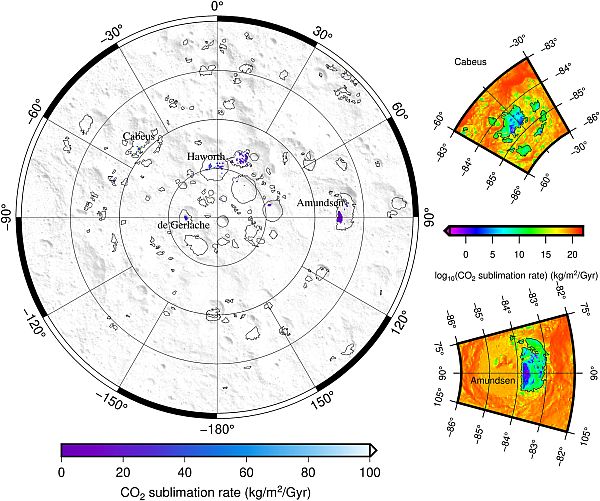
Moon exhibits tenuous atmosphere. Its low gravity enables gases to escape into the outer space effortlessly. Heavier atoms, however, are ionised by sun’s ultraviolet radiation, which are then drifted away from the Moon by the solar flares.
In one science experiment of Apollo 17 Mission, primarily three gases in equal measures were detected, that is, neon, helium, and hydrogen. In addition, tiny fractions of methane, carbon dioxide, ammonia, and water were also observed.
For a long time, researchers were not sure about the presence of carbon dioxide cold traps enveloping solid carbon dioxide at the peripheral regions of moon. However, Norbert Schörghofer’s led team at American Geophysical Union have confirmed the existence of lunar carbon dioxide cold traps.
Moon’s peripheral regions, that is, at the poles, temperature falls below the coldest regions of Pluto. This results in carbon dioxide cold traps. Within these traps, the molecules of CO2 remain in solid form, irrespective of high temperatures in the lunar summer.
Harnessing the solid carbon dioxide
If scientists were able to harness the solid carbon dioxide in these cold traps, they will be able to produce fuel and other materials for longer lunar stays. And in the near future, explorers will then be able to build an underground moon base.
Also, carbon dioxide and other potential volatile organics will help them to determine the origins of water and other elements on the moon.
Current theory holds asteroids & comets impacts and volcanic eruptions responsible for the origins of elements on the surface of moon, which of course cannot be ruled out.

Lunar cold traps
The study established the presence of cold traps in lunar regions, a phenomenon which was hypothesized by planetary scientists since long. American Geophysical Union’s researchers observed temperature data of nearly 11 years.
To locate the coldest spots on the moon’s surface, they employed the Diviner Lunar Radiometer Experiment, an instrument flying aboard NASA’s Lunar Reconnaissance Orbiter.
The total area of these carbon dioxide traps is about 204 square kilometers. Amundsen Crater, which at the moment is the largest area alone is nearly 82 square kilometers. Temperature in these areas always remain about minus 352 degrees Fahrenheit
Takeaway
Primarily the study might help scientists in understanding the volatiles on the moon and their delivery from elsewhere in the solar system.
Confirmation of carbon dioxide cold traps on the moon not only hints at the planned future lunar exploration but also leads to framing of international policy regarding the resource.
After all, the cold traps enveloping solid carbon dioxide could be used in numerous ways. Rocket fuel, biomaterials for long robotic missions or creating building blocks for moon base station, has already attracted interests from governments and private companies.



